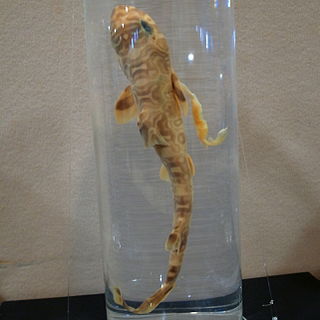
A tuna is a saltwater fish that belongs to the tribe Thunnini, a subgrouping of the Scombridae (mackerel) family. The Thunnini comprise 15 species across five genera, the sizes of which vary greatly, ranging from the bullet tuna up to the Atlantic bluefin tuna, which averages 2 m (6.6 ft) and is believed to live up to 50 years.

Mackerel is a common name applied to a number of different species of pelagic fish, mostly from the family Scombridae. They are found in both temperate and tropical seas, mostly living along the coast or offshore in the oceanic environment.

Herring are forage fish, mostly belonging to the family of Clupeidae.

The term carp is a generic common name for numerous species of freshwater fish from the family Cyprinidae, a very large clade of ray-finned fish mostly native to Eurasia. While carp are prized quarries and are valued as both food and ornamental fish in many parts of the Old World, they are generally considered useless trash fish and invasive pests in many parts of Africa, Australia and most of the United States.

Sardine and pilchard are common names for various species of small, oily forage fish in the herring family Clupeidae. The term 'sardine' was first used in English during the early 15th century; a somewhat dubious folk etymology says it comes from the Italian island of Sardinia, around which sardines were once supposedly abundant.

Wobbegong is the common name given to the 12 species of carpet sharks in the family Orectolobidae. They are found in shallow temperate and tropical waters of the western Pacific Ocean and eastern Indian Ocean, chiefly around Australia and Indonesia, although one species occurs as far north as Japan. The word wobbegong is believed to come from an Australian Aboriginal language, meaning "shaggy beard", referring to the growths around the mouth of the shark of the western Pacific.

The billfish are a group of saltwater predatory fish characterised by prominent pointed bills (rostra), and by their large size; some are longer than 4 m (13 ft). Extant billfish include sailfish and marlin, which make up the family Istiophoridae; and swordfish, sole member of the family Xiphiidae. They are often apex predators which feed on a wide variety of smaller fish, crustaceans and cephalopods. These two families are sometimes classified as belonging to the order Istiophoriformes, a group which originated around 71 million years ago in the Late Cretaceous, with the two families diverging around 15 million years ago in the Late Miocene. However, they are also classified as being closely related to the mackerels and tuna within the suborder Scombroidei of the order Perciformes. However, the 5th edition of the Fishes of the World does recognise the Istiophoriformes as a valid order, albeit including the Sphyraenidae, the barracudas.

The bala shark also known as the tricolor shark, tricolor sharkminnow, silver shark, or shark minnow, is a fish of the family Cyprinidae, and is one of the two species in the genus Balantiocheilos. This species is not a true shark, but is commonly so called because of its torpedo-shaped body and large fins.

The sixgill sawshark, Pliotrema warreni is a sawshark of the family Pristiophoridae. Presence of 6 pairs of gill slits highlights this genus among sharks; outside Hexanchiformes order, Pliotrema is the only shark with more than 5 gill slits. Unlike other sawsharks, the barbs on this shark's rostrum continue onto the sides of the head. Its barbels are also closer to its mouth than in other species. At maximum, females can reach over 136 cm long, and males can reach over 112 cm long.

The onefin catshark is a species of catshark, and part of the family Scyliorhinidae. It is the only member of its genus.

The spotless catshark is a catshark of the family Scyliorhinidae found in the South China Sea at depths between 535 and 1,020 m on the continental slope. Its length is up to 71 centimetres (28 in).

The shortnose demon catshark is a catshark of the family Scyliorhinidae found only in deep water in the East China Sea. Its length is up to 40 cm. A. internatus is known only from the holotype and a paratype, both caught in the East China Sea, probably taken as bycatch in deepwater trawl fisheries. The reproduction of this catshark is oviparous.

The cylindrical lanternshark or Carter Gilbert's lanternshark is a shark of the family Etmopteridae found along the Caribbean coast of Colombia in South America, at depths of between 285 and 355 m. Its maximum length is 21 cm.

The ocellate topeshark is a species of houndshark, belonging to the family Triakidae. It is found in the western Pacific from the Ryukyu Islands to the Philippines and Taiwan.

Eels are ray-finned fish belonging to the order Anguilliformes, which consists of eight suborders, 20 families, 164 genera, and about 1000 species. Eels undergo considerable development from the early larval stage to the eventual adult stage and are usually predators.

An anchovy is a small, common forage fish of the family Engraulidae. Most species are found in marine waters, but several will enter brackish water, and some in South America are restricted to fresh water.

Leuciscinae is a subfamily of the freshwater fish family Cyprinidae, which contains the true minnows.
Alexandr Vladimirovich Gussev, sometimes spelled Gusev in the literature, was a Russian helminthologist specialist of monogeneans.


















